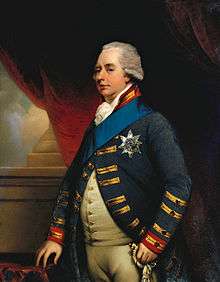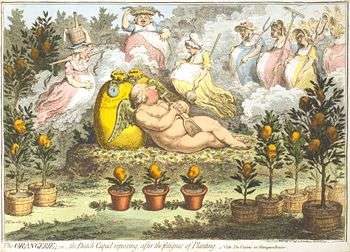William V, Prince of Orange
| William V | |||||
|---|---|---|---|---|---|
 Portrait by Henry Bone (1801) | |||||
| Stadtholder of the United Provinces | |||||
| Reign | 22 October 1751 – 9 April 1806 | ||||
| Predecessor | William IV | ||||
| Successor | Stadtholdership abolished | ||||
| Prince of Orange | |||||
| Reign | 22 October 1751 – 9 April 1806 | ||||
| Predecessor | William IV | ||||
| Successor | William VI | ||||
| Born |
8 March 1748 The Hague | ||||
| Died |
9 April 1806 (aged 58) Brunswick | ||||
| Spouse | Wilhelmina of Prussia | ||||
| Issue |
Louise, Hereditary Princess of Braunschweig William I of the Netherlands Prince Frederick of Orange-Nassau | ||||
| |||||
| House | Orange-Nassau | ||||
| Father | William IV, Prince of Orange | ||||
| Mother | Anne of Great Britain | ||||
| Religion | Dutch Reformed Church | ||||
William V, Prince of Orange (Willem Batavus; 8 March 1748 – 9 April 1806) was the last Stadtholder of the Dutch Republic. He went into exile to London in 1795. He was the reigning Prince of Nassau-Orange until his death in 1806. In that capacity he was succeeded by his son William.
Early life
William Batavus was born in The Hague on 8 March 1748, the only son of William IV, who had the year before been restored as stadtholder of the United Provinces. He was only three years old when his father died in 1751, and a long regency began. His regents were:
- Dowager Princess Anne, his mother, from 1751 to her death in 1759;
- Dowager Princess Marie Louise, his grandmother, from 1759 to her death in 1765;
- Duke Louis Ernest of Brunswick-Lüneburg, from 1759 to 1766, and kept on as a privy counsellor until October 1784;
- Princess Carolina, his sister (who at the time was an adult aged 22, while he was still a minor at 17), from 1765 to William's majority in 1766.
William was made the 568th Knight of the Order of the Garter in 1752.
Stadtholder
William V assumed the position of stadtholder (chief executive) and Captain-General of the Dutch States Army in 1766. On 4 October 1767 in Berlin, Prince William married Princess Wilhelmina of Prussia, the daughter of Augustus William of Prussia, niece of Frederick the Great and a cousin of George III. He became an art collector and in 1774 his Galerij Prins Willem V was opened to the public.
.jpg)
The position of the Dutch during the American War of Independence was one of neutrality. William V, leading the pro-British faction within the government, blocked attempts by pro-independence, and later pro-French, elements to drag the government to war in support of the Franco-American alliance. However, things came to a head with the Dutch attempt to join the Russian-led League of Armed Neutrality, leading to the outbreak of the Fourth Anglo-Dutch War in 1780. In spite of the fact that Britain was engaged in fighting on several fronts, the war went badly for the badly prepared Dutch and the Republic was eventually forced to cede some territory to the British. After much political debate and pressure from American and French diplomats such as John Adams, Joan van der Capellen tot den Pol and Court Lambertus van Beyma took the initiative.
After the signing of the Treaty of Paris (1783), there was growing restlessness in the United Provinces with William's rule. In the meantime, a band of young revolutionaries, called Patriots, was challenging his authority more and more. In 1785 William left the Hague and removed his court to Guelders, a province remote from the political centre. In September 1786 he had to send an army to stop Herman Willem Daendels, organizing an overthrow at the cities' vroedschap. In June 1787 his energetic wife Wilhelmina tried to travel to the Hague. Outside Schoonhoven, she was stopped by militia, taken to a farm near Goejanverwellesluis and within two days made to return to Nijmegen.
To Wilhelmina and her brother, Frederick William II of Prussia, this was an insult. Frederick sent in an army to attack the dissidents. Many Patriots fled to the North of France, around Saint-Omer, in an area where Dutch was spoken. Until his overthrow they were supported by King Louis XVI of France.
Exile in Great Britain

With the coming of the French Revolution William V joined the First Coalition against Republican France in 1793. His troops fought bravely in the Flanders Campaign, but in 1794 the military situation deteriorated and the Dutch Republic was threatened by invading armies. The year 1795 was a disastrous one for the ancien régime of the Netherlands. Supported by the French Army, the revolutionaries returned from Paris to fight in the Netherlands, and in 1795 William V went into exile in England. A few days later the Batavian Revolution in Amsterdam occurred, and the Dutch Republic was replaced with the Batavian Republic.[1]:1121 [2]:190–192
Directly after his arrival in England the Prince wrote a number of letters (known as the Kew Letters) from his new residence in Kew to the governors of the Dutch colonies, instructing them to hand over their colonies to the British "for safe-keeping." Though only a number complied this contributed to their confusion and demoralisation. Almost all Dutch colonies were in the course of time occupied by the British, who in the end returned most, but not all (South Africa and Ceylon), first at the Treaty of Amiens and later with the Convention of London 1814.[1]:1127
In 1799 the Hereditary Prince took an active part in the Anglo-Russian invasion of Holland, engineering the capture of a Batavian naval squadron in the Vlieter Incident. The surrender of the ships (that had been paid for by the Batavian Republic) was formally accepted in the name of William V as stadtholder, who was later allowed to "sell" them to the Royal Navy for an appreciable amount.[3] But that was his only success, as the troops suffered from choleric diseases, and civilians at that time were unwilling to re-instate the old regime. The arrogance of the tone in his proclamation, demanding the restoration of the stadtholderate, may not have been helpful, according to Simon Schama.[2]:393–394
After the Peace of Amiens in 1802, in which Great Britain recognised the Batavian Republic, an additional Franco-Prussian Convention of 23 May 1802 declared that the House of Orange would be ceded in perpetuity the domains of Dortmund, Weingarten, Fulda and Corvey in lieu of its Dutch estates and revenues (this became the Principality of Nassau-Orange-Fulda). As far as Napoleon was concerned this cession was conditional on the liquidation of the stadtholderate and other hereditary offices of the Prince. William V, however had no interest in towns, territories and abbeys confiscated from other rulers, but wanted what was his due: his arrears in salaries and other financial perquisites since 1795, or a lumpsum of 4 million guilders. The foreign minister of the Batavian Republic, Maarten van der Goes, was willing to secretly try to persuade the Staatsbewind of the Batavian Republic to grant this additional indemnity, but Napoleon put a stop to it, when he got wind of the affair.[2]:452–454
The last of the Dutch stadtholders, William V died in exile at his daughters palace in Brunswick, now in Germany. His body was moved to the Dutch Royal Family crypt in the Nieuwe Kerk in Delft on 29 April 1958.
In 1813, his son, King William I returned to the Netherlands and became the first Dutch monarch from the House of Orange.
Issue
.jpg)
William V and Wilhelmina of Prussia were parents to five children:
- An unnamed son (23–24 March 1769).
- Frederika Luise Wilhelmina (The Hague, 28 November 1770 – The Hague, 15 October 1819), married in The Hague on 14 October 1790 Karl, Hereditary Prince of Braunschweig (London, 8 February 1766 – Antoinettenruh, 20 September 1806), a son of Karl Wilhelm Ferdinand, Duke of Brunswick-Luneburg and Princess Augusta of Great Britain, without issue.
- An unnamed son (born and deceased on 6 August 1771).
- William I, King of the Netherlands (25 August 1772 – 12 December 1843).
- Willem Georg Frederik, Prince of Orange-Nassau (The Hague, 15 February 1774 – Padua, 6 January 1799), unmarried and without legitimate issue.
Ancestry
See also
References
- 1 2 Israel, J.I. (1995). The Dutch Republic. Its Rise, Greatness, and Fall 1477-1806. Clarendon Press.
- 1 2 3 Schama, Simon (1992). Patriots and Liberators. Revolution in the Netherlands 1780-1813. Vintage books.
- ↑ James, W.M. (2002). The Naval History of Great Britain: During the French Revolutionary and Napoleonic Wars. Vol. 2 1797-1799. Stackpole books. pp. 309–310.
External links
-
 Media related to William V, Prince of Orange at Wikimedia Commons
Media related to William V, Prince of Orange at Wikimedia Commons
| William V, Prince of Orange Cadet branch of the House of Nassau Born: 8 March 1748 Died: April 9 1806 | ||
| Dutch nobility | ||
|---|---|---|
| Preceded by William IV |
Prince of Orange 1751–1806 |
Succeeded by William VI |
| Regnal titles | ||
| Preceded by William IV of Orange |
Prince of Orange-Nassau 1751–1806 |
Succeeded by William VI of Orange |
| Baron of Breda 1751–1795 |
Lordship dissolved incorporated in Batavian Republic | |
| General Stadtholder of the United Provinces 1751–1795 |
Function abolished followed by Batavian Republic | |